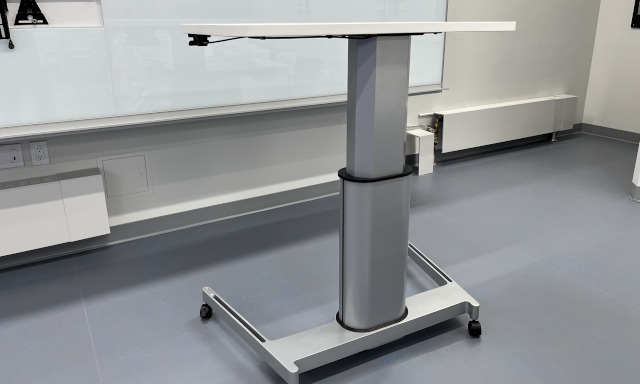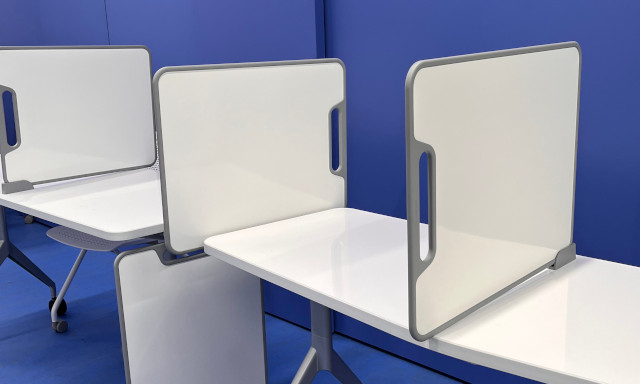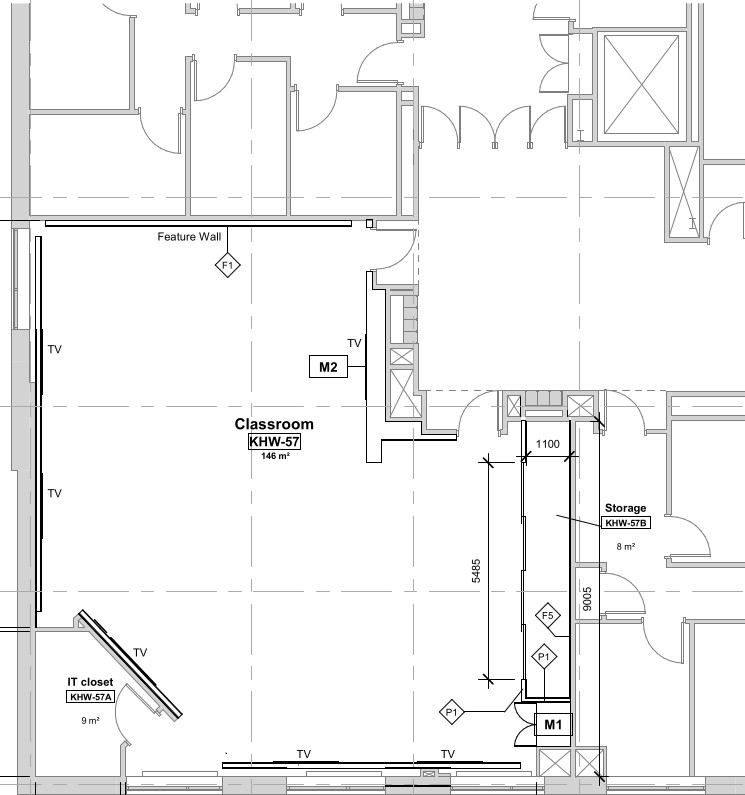Learn about the Active Learning Classroom
Virtual Tour of Active Learning Classroom
Goals of the Active Learning Classroom
The Active Learning Classroom was designed to incorporate the learning space design values (opens in new window) developed by the Teaching and Learning Spaces Working Group and to reflect the Indigenous design principles identified through the (google doc) Indigenous Community Consultations (external link, opens in new window) . The classroom intentionally supports the wellbeing of all users through the use of design elements such as tunable white lighting, accessible furniture, and the incorporation of Indigenous art.
The intent of this space is to encourage faculty to incorporate active learning pedagogy into their courses and to experiment with pedagogical development and design in the classroom. Overall, the classroom is meant to create positive spaces for learners on campus and to improve student learning outcomes through
- Learning with Peers (Collaborative Learning)
- Engaging with Faculty
- Academic Challenge
Classroom Features
The Active Learning Classroom includes a variety of features chosen to support the effective use of active learning pedagogy in the classroom. The classroom has been designed to encourage active collaboration between students and instructors and incorporates the (google doc) Community Consultations on Design Standards for Indigenous Spaces (external link, opens in new window) on campus.
Explore the specific features of the Active Learning Classroom below, or consult the (google doc) ALC Features document (external link, opens in new window) .
The Active Learning Classroom features a large selection of flexible, moveable furniture to accomodate a variety of classroom layouts and student seating preferences.
Student Chairs
Moveable (wheeled) student chairs allow for ease of movement within the classroom, enabling group work and easy-to-adapt classroom layouts

Height Adjustable Table
Moveable (wheeled) height-adjustable student table provides accomodation for students with seated or standing height preferences, and provides a large presentation surface for demonstrations.
Balance Stools
The balance stools provide students with flexibility and choice of seating. The balance stools are moveable and height-adjustable and can be used with student tables or as an alternative seating choice during student group work.
These balance stools provide an accessible option for neurodivergent learners in the classroom.
Instructor Podium
The instructor podium is height-adjustable and fully mobile, allowing instructors to teach from anywhere within the classroom.
Student Tables
Moveable (wheeled) student tables accommodate 2-4 students. Table tops are made of a dry-erase surface, allowing students to work collaboratively on a variety of tasks. Each table also includes 2 dry-erase "buddy boards"
Bench Seating
Bench seating provides students and instructors with flexibility and choice of seating. The benches can be used with student tables for classwork, to set up panel discussions, or as an alternative seating choice during student group work. The benches are moveable.

Instructor Chair
The height-adjustable instructor chair is moveable (wheeled) and allows instructors to teach while seated from anywhere in the classroom.
The Active Learning Classroom is designed to be a fully collaborative learning space. All of the moveable (wheeled) furniture can be used for collaborative purposes, but additional furniture described below encourages instructors and students to engage in collaborative activities.

Buddy Boards
Each student table comes with two dry-erase buddy boards that can be removed and used by students around the classroom or used as table dividers to allow for privacy. The buddy boards allow for increased student collaboration and flexibility within the classroom.

Collaborative (Pentagonal) Table
The two pentagonal collaborative tables allow students to gather in small groups of 2-5 to actively work together on problems or discuss class content.
These tables can also be used to conduct small-group tutorials or discussions.
Tunable Lighting
The Active Learning Classroom features tunable white lighting, allowing instructors to more effectively control the temperature of the lighting within the classroom. This will allow for lighting that better adapts to teaching methods or content, as well as lighting that can help mimic natural circadian rhythms, improving overall wellness.
The Active Learning Classroom's design removes the traditional "defined front" of most teaching environments. By installing presentation surfaces along nearly every wall, instructors have choices about where to present information, and whether to do so along each surface simultaneously or not.
.jpg)
A/V Screens
A/V Screens have been installed along the East, South-East, South, and West walls of the classroom, allowing for an undefined front for teaching. Instructors can use the screens to project the same content or different content, depending on teaching preference.
Students will also be able to connect directly to these screens while working in small groups, allowing students to present and share their personal screens.
Continuous Dry-erase Boards
Continuous, dry-erase glass writing surfaces are installed along the East, South-East, South, and West walls of the classroom, allowing for an undefined front for teaching.
Students can also use these writing surfaces while working in small groups, allowing for greater student agency in learning
"Unfettered Access for our Grandchildren"
This mural by TMU alumnus and Indigenous artist Miranda Black incorporates Indigenous knowledges and teachings into the active learning classroom. The QR code to the right of the mural links instructors and students to additional information regarding the many different elements of the mural and commentary from artist Miranda Black, Director of Aboriginal Initiatives Monica McKay, and Elder & Senior Advisor Joanne Delaire.
.png)
.png)
The ALC is home to four young beech trees who are already experienced guides of active learning. These trees are originally from the Haliburton Forest & Wildlife Reserve on Michi Saagiig territory, where the spread of Beech Bark Disease (BBD) threatens the survival of this species. These small-diameter trees were harvested as an act of preservation before they fell susceptible to BBD. Their removal contributed to the forest’s health by making way for the growth of larger trees. Dr. Zachary Mollica, Associate Professor and former Emerging Architect Fellow at the University of Toronto Daniels Faculty of Architecture, Landscape and Design, brought the trees into his classroom (external link) where they supported hands-on learning for early-career architects through woodworking and learning to design with natural materials. “Each time you carve one of these trees, you find something you didn't know about the way a branch moves or the way the tree has grown,” says Mollica. “Working into a piece of wood and thinking about what you’re seeing is both very enjoyable, but also quite teaching.”
At the end of the fellowship, the trees found their new home in TMU’s Active Learning Classroom with the help of Daniels Master of Landscape Architecture student, Bracha Stettin. The trees are intended to support the ALC as a dedicated Indigenous learning space by bringing nature inside and integrating natural elements and systems into the learning experiences. These trees are meant to be touched (but not moved!) and regarded as valuable community members and teachers in the learning environment.
Supplies Storage
A lockable supply cabinet allows for the storage of Active Learning Classroom supplies and materials.
Furniture Storage
Student chairs and tables in the Active Learning Classroom nest to allow for unused furniture to be easily stored in the furniture closet (East wall).
Room Information
| General Information | |
|---|---|
| Room | KHW-057 |
| Building | Kerr Hall West |
| Capacity | 52 |
| Furniture | Flexible Seating |
| Accessibility | Fully accessible |
| Technology | Mobile Podium |

